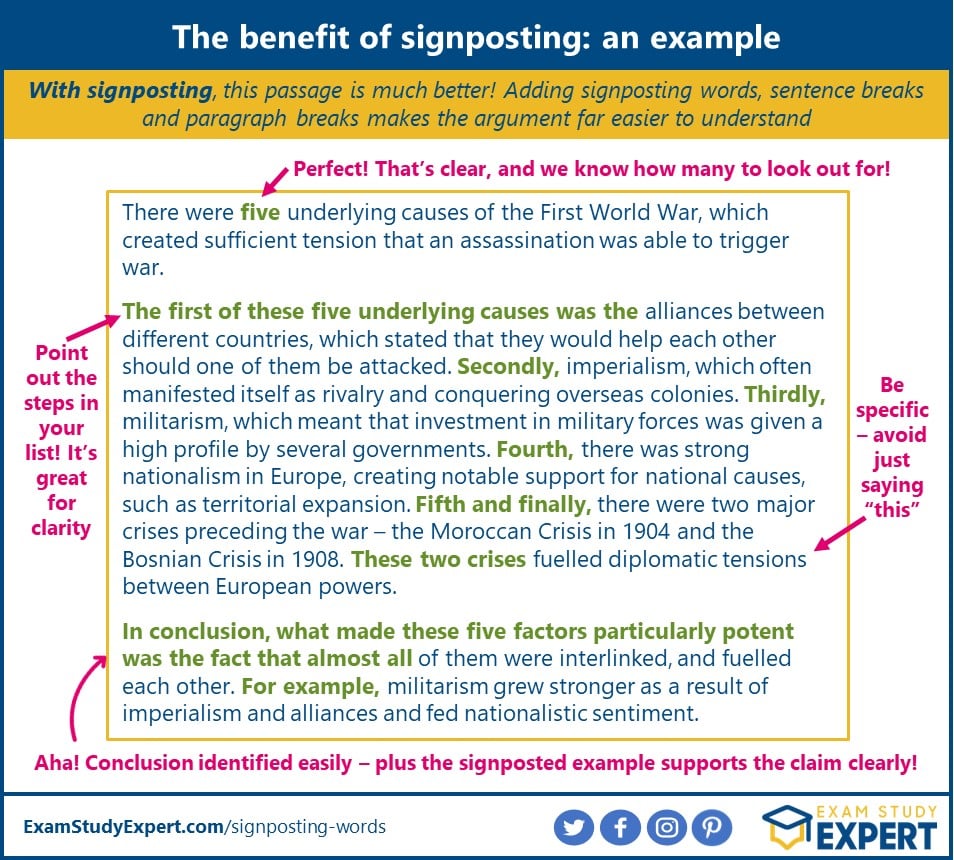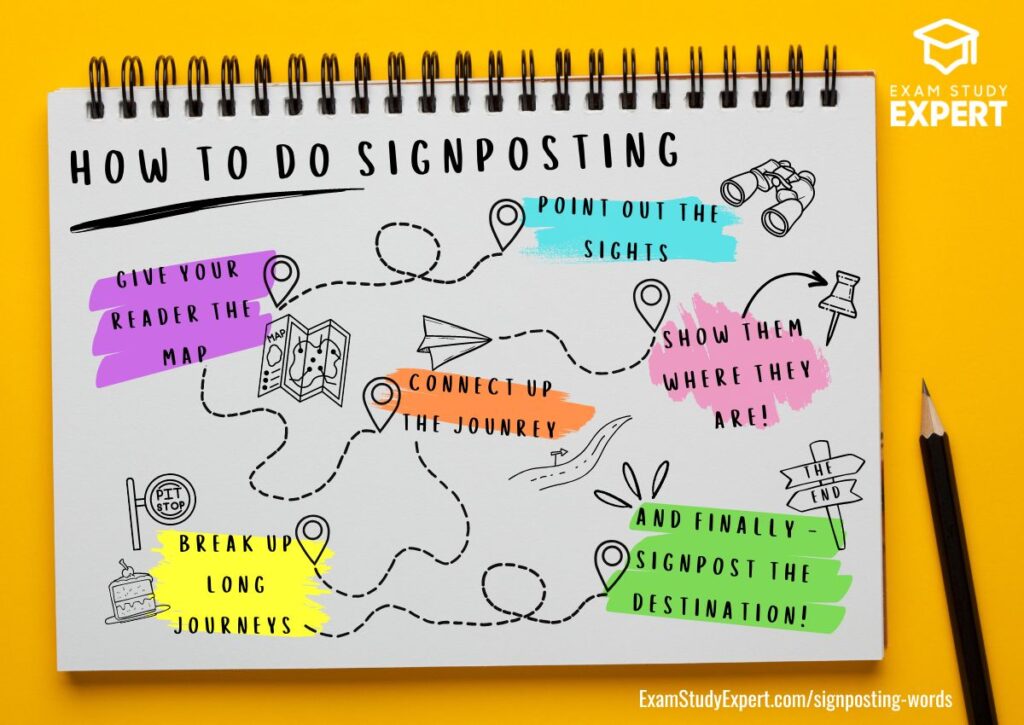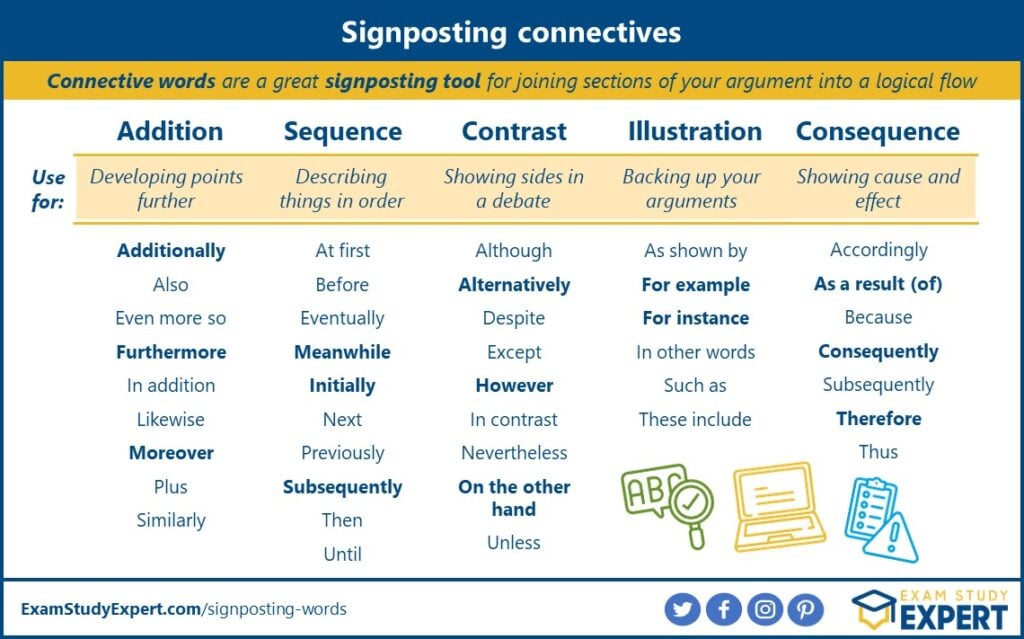Looking to take your essay to the next level WITHOUT learning a load of complex structures, knotty grammar and fancy vocabulary? It’s simple: start using signposting words and you’ll level up your essays, dissertations and assignments in no time at all!
And here’s how to use signposting words to improve your writing in 5 easy steps:
First up, what is signposting in writing?
Not sure what I’m talking about? It’s actually pretty simple:
Signposting in writing acts just like signposts on a hike! Imagine a handily placed wooden post that proudly proclaims “You are here! Conclusion: 3 miles“.
Essentially, they stop your reader from getting lost in the forest of your words and arguments.
Using signposting in your essays is all about adding strategically placed words and phrases to create a clear map of your structure. You need to scatter them throughout the path of your essay to show your reader where they are in the discussion and what’s up next – just like the physical signposts that point the way on a hike!
There are two common uses for signposts in your writing:
- Firstly, to point out the structure of your overall essay or next section / chapter – usually in the introduction
- And secondly, to remind your reader of that structure and show how everything links together
You probably already use some signposting words and phrases naturally as you write. Did you spot how I used it in the bullet points above?
For a truly top-mark essay, it’s best to plan out where you want to put some signposts to make your essay as streamlined and persuasive as possible!
Why bother using signposting words? An example!
There are plenty of benefits to using signposting words and phrases in your writing!
Most importantly, signposting language improves the clarity and readability of your essay. These are both important things that help your examiner understand your argument as smoothly as possible (great for top marks!).
Your examiner / teacher won’t get lost, have to re-read a paragraph or two, get frustrated … and dock you marks! All achieved by some simple, well-placed vocab.
Let me show you the power of using signposting words in your essay writing:
Take a look at this example of writing without any signposting language. It reads like a series of disjointed information. Do you understand it easily?

So how can we improve this paragraph, and make the structure of our argument crystal clear – simply by adding signposting words?
Take a look at the next version of this example, now with signposting – it’s so much easier to understand!

Thanks to History On The Net for refreshing my high school history to be able to write these examples…
You can see how the highlighted green signposting language immediately makes the listed causes and examples easily identifiable. As an added bonus: any vague phrases (“several factors”, “these factors”) have been clarified with specifics, and paragraph breaks make the structure obvious!
Signposting makes everyone happy – trust me!
Your examiners, teachers and tutors LOVE it when you use signposting. And not just because it makes their job easier! But because:
- It makes you sound AMAZING:
- Using signposting properly helps your writing sound professional, establishing your authority and skill in your topic instantly. This is a great skill to develop before college applications are due!
- Plus, you’re creating a sense of anticipation for what is to come in your reader – you’ll make reading your arguments enjoyable!
- It makes your work QUICKER to comprehend:
- No one loves spending time marking, so by making your reader’s life easier, they may be inclined to generosity when it comes to awarding your mark.
- It makes sure you get the CREDIT YOU DESERVE:
- By making your argument and structure as clear as possible, you give yourself the best possible chance of getting all the credit you deserve! Both for the quality of the points you made, and the style with which you strung them together.
How to use signposting words in your writing: 5 easy steps!
So, how to start incorporating signposting into your essays?
Remember that analogy between signposting language and actual signposts that keep you from getting lost on countryside hikes?
Well, it’s time to set out your latest essay draft on the table like an unchartered forest, and make a map! Your signposting vocab list: that’s your stash of wooden arrows to hammer into the ground next to forks in the trees. Or (if you prefer different imagery) your Hansel and Gretel breadcrumbs, or luminous glow-sticks!
So grab a pen and some scrap paper for mapping out your overall structure and noting where you might need a signpost. And then start at the beginning 😊
Leave no reader behind!

Step 1: Give your reader the map
One of the most important places to add clear signposting words to your essay is right at the beginning, in the introduction.
This is where you hand your unsuspecting reader a map that shows them what to expect from the structure of your essay.
Here’s an example of structural signposting in an introduction:
“This essay will explore the beautiful scenery surrounding Yorkshire’s magical Malham Cove. The analysis begins with a gentle riverside stroll to explore the argument surrounding the history of Janet’s Foss. This is followed by a short walk into the dramatic evaluation of five pros and cons of rock climbing at Gordale Scar. Next, this essay will examine the geological evidence during a scenic hilly stroll across to the beautiful Limestone Pavement at the top of Malham Cove. Finally, the conclusion will draw together the themes of history and tourism and will suggest that future walks should be finished at the pub in Malham.
Immediately, our reader (or hiker) will know to expect in order: an analysis, historical argument, five pros and cons, and an examination of the evidence. And they also know what themes and suggestions our conclusion will focus on – great for keeping their mind focused on these concepts as they read.

In our short WWI example above, the map is quite simple but clear. I started by saying that “there were five interlinked causes”. That’s all that was needed for our reader to know to watch for 5 signposts on the route!
Top tip: It’s important to be as specific as you can when signposting! Notice there were five causes, and five pros and cons. Not “some causes“, not even “the pros and cons“. That number is really helpful in setting out the map.
Here are some more examples of introductory signposting in action:
- Simple list of points or steps:
- “There are six reasons why…”
- “… happened in eight steps”
- “We need to evaluate three factors when deciding…”
- For and against:
- “There are two reasons to support X, and three reasons to support Y.”
- “There are three good reasons to …, but one strong reason not to”
A good introduction should include at least one sentence with signposting like this, to prepare your reader.
Want to learn some more kick-ass techniques for starting your essay off on the right foot? Check out our guide to all things introduction, from mysteries and drama to facts and assumptions!
Step 1 BONUS: point out the sights for a more detailed map
For longer essays or dissertations, you might offer more than a single introductory paragraph.
In that case, part of your signposting might be a short description of what each area of discussion or chapter will cover:
- For example, heading back to the causes of WWI: if we were writing several long paragraphs exploring the historical context of each of the five causes, then setting all five out in the introduction would be helpful to the reader.
This style of signposting makes use of lots of listing words and phrases: firstly, secondly, this will be followed by … and is often presented in a long list following a colon ( : ) and separated by semi-colons ( ; ).
You might also give an overview of any facts and evidence explored, or theories questioned.
- Think of it like a note in your hike directions: “Along this stretch of the river there have been several reported sightings of the elusive signposting moth, and this analysis will examine their validity in light of …“
This will give your reader a better understanding of the arguments within your overall structure – and fuel their anticipation!
Here are some examples of signposting phrases for complex arguments:
- “This essay will consider the topic under the following 8 headings.”
- “First, evidence for … will be put forward.”
- “Second, I will discuss …”
- “This will lead, third, to an examination of…”
- “… which will be followed, fourth, by exploration of…”
Here’s a quick toolbox of useful verbs you can use to keep your writing varied when presenting more complex “maps” of this nature: discuss, divide, examine, explore, present, put forward evidence for.
Step 2: Show them where they are on your map
If you’ve given your reader a clear map at the start, then this step is simple to add to your essays! It’s the big “YOU ARE HERE!” marker on the map.
As you progress through your essay – and especially at the start of new sections:
You just refer back to the structure you told them you were following, and explain which section you are moving into as you make each fresh argument.
For a simple list of points (as in the First World War example above), this could be as simple as starting each paragraph with a signposting word that points to your list (in words, never a numeral!):
- “The first of these five underlying causes was …”
- “Secondly, imperialism, which often …“
- “Fourth, there was strong nationalism in …”
For longer essays, your reminder signposts might be as simple as repeating the purpose of this next section. State your signposting directly and clearly, for example:
- This analysis of the arguments surrounding the history of Janet’s Foss begins with …
- Following on from this dispute, it is necessary to examine the geological evidence found on the Limestone Pavement at the top of Malham Cove.
Even if a reader is skimming your essay quickly, it will still be obvious where they are in the overall structure of your argument. Even better, it makes it easy for them to skip ahead or go back to check an earlier point without getting totally lost.
Step 3: Use connectives to join up the journey
When it comes to effective essay writing, connective words are an important tool in your arsenal.
And connective words can be a great help when it comes to signposting too. Think of them as a thread you can use to connect your essay into a logical flow (detours included!).
Having a list of signposting connective words on hand is great for linking together points, paragraphs and arguments. You can use them to:
- Show contrasting sides of a debate
- Develop a point further
- Describe things in order
- Provide examples
- Demonstrate results
So to get you started, here’s a list of some of the top signposting words for connecting up your essay:

Here are some examples of how you can put together connecting signposting words at the start of a new section to indicate different things:
- Nevertheless, the following two counter-arguments are …
- Furthermore, we found that X was … as demonstrated by …
- Third, and in contrast, X was not a common feature of …
Step 4: Break up long journeys with paragraph breaks and subheadings
Nobody likes encountering a long and daunting wall of text.
Happily, paragraph breaks are a form of signposting in and of themselves. They show the reader when you are entering a new sub-section of your argument.
I’m not a big fan of a hard-and-fast rules about how many sentences a paragraph should contain: some sentences are short, others are long. Sometimes, a good paragraph might only be a couple of relatively long sentences. Other times, you might have five or six shorter ones.
If you’re not sure about the paragraph conventions of your writing genre, check out our ultimate guide to paragraph lengths for some specific advice!
In the meantime, remember that:
- It’s OK to split the same point over two paragraphs if you need to:
- Signposting will help to keep your essay clear even as you make longer, multi-paragraph points. Use connectives to indicate which paragraphs belong to which sections of your overall structure.
- For longer, dissertation-style essays, you should be using headings and subheadings as well.
- In many areas of academia, there is an established protocol for headings (e.g. “Abstract / Introduction / Methodology / Results / Conclusion”).
- Feel free to add subheadings under these major headings if you feel it will help your reader, especially in the sections that tend to get longer, such as the Methodology and Results.
Top Tip: Make sure to check that your newly signposted sentences and paragraphs still make sense grammatically with available tools such as Grammarly * – even the free version will give your mistake-checking a boost!
5. Signpost the destination to conclude smartly
Finally, be sure to wrap things up with a clear conclusion statement that heralds your reader’s arrival back at the pub in Malham after their long (but hopefully enjoyable) hike!
You might begin with a phrase like this:
- To summarise
- To sum up
- In conclusion
- To conclude
- Finally
Your conclusion might also remind the reader of all the sights they’ve strolled through – a sort of reverse of the introduction, in which all your threads are pulled together to support your concluding arguments.
Here are some examples of concluding signposting phrases in action:
“Finally, to summarise the geological and historical debates surrounding the impact of tourism in Malham Cove …”
“In conclusion, while these five factors were powerful on their own, what in my opinion made them particularly dangerous was their interlinked nature, where one would fuel the other…”
And so, in conclusion…
…when used well, signposting words will help YOU do well in your essays this year.
Just remember to make it obvious, and be specific – especially when it comes to numbers!
And once you’ve got your essay written and signposted, check out my guides for successful proofreading, and printing and binding, to make sure that you hand in a winning assignment!
For more help becoming a phenomenal essay and exam-answers writer, I am currently accepting clients for 1:1 coaching – read more and get in touch here.
* Please note: Grammarly is one of very few products I’m sufficiently enthusiastic about to recommend to my readers, and I may earn a small commission if you sign up to Grammarly services through the above link.
- [PODCAST] Peps McCrea: Hacking Study Motivation With Psychology - 27 Jan 2024
- Your Word Of The Year – Setting You Up For Success [PODCAST] - 2 Jan 2024
- Holiday Season Study Tips [PODCAST] - 21 Dec 2023



